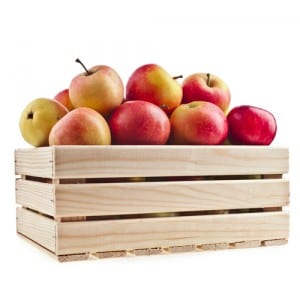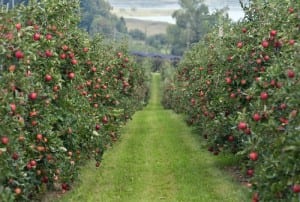
Everett Griner talks about the history of the apple in today’s Agri View.
Apple Orchards
From: U.S. Apple.org
Apples In History
Apples have existed for the length of recorded history, believed to have originated in the Caucasus, a mountainous area between what is now the Black and Caspian Seas. The people of that region are commonly considered the ancestors of most of the peoples of modern Europe, Persia, Afghan and India − apparently taking apples along with them.
 Apples´ fortunes waxed and waned throughout history. Cultivation and enjoyment of apples was an essential part of civilized life during the Persian Empire, grown as much for their aesthetic pleasures as for good food. The Greeks acquired the Persian affinity for apples when they assumed dominance in the third century B.C. Later the food customs and horticultural skills acquired from the Persians and Greeks migrated with the epicurean Romans westward into Europe, rising to the level of both art and science.
Apples´ fortunes waxed and waned throughout history. Cultivation and enjoyment of apples was an essential part of civilized life during the Persian Empire, grown as much for their aesthetic pleasures as for good food. The Greeks acquired the Persian affinity for apples when they assumed dominance in the third century B.C. Later the food customs and horticultural skills acquired from the Persians and Greeks migrated with the epicurean Romans westward into Europe, rising to the level of both art and science.
As the Roman Empire declined, however, so did apple growing for a time. In fact, many of the varieties and techniques would have been lost had it not been for the monastic orcharding traditions of the Christian church through the twelfth century. In the East, fruit growing was saved and actually expanded by the rise of Islam, the tenets of which encouraged botany.
Apple growing, for both food and spectacle, arose again in fifteenth-century Renaissance Italy. Contributing to this revival was the advent of cooking with sugar, and a decline of earlier religious concerns. France and England followed suit, and fruit remained king in Europe well into the 1800s.
European settlers of the Americas brought with them their English customs and favorite fruits, much favored over the native crab apple.
The Lady apple, a variety still grown today, is believed to be one of the oldest varieties on record, documented as far back as the first century A.D. (Wynne)
The oldest apple recipe on record, for Diced Pork and Matian Apples, comes from De Re Coquinaria (“On Cookery”), dating from the third century and attributed to a gourmand named Apicius, who lived two centuries before.
The story that Newton discovered the law of gravity after watching an apple fall from a tree is probably backwards, thought to evolve from his having used the apple’s fall to illustrate the pull of gravity.
 Apples in America
Apples in America
Only sour crab apple trees were native to America, until European settlers arrived and brought with them their English customs and favorite fruits. Native Americans appropriated what they liked, cultivating apples extensively.
Americans´ fondness for seedling orchards − that is, orchards grown from seeds rather than propagation by grafting − resulted in many hundreds of new varieties more suited to the native environment. By the turn of the nineteenth century, most varieties offered by professional nurseries were native to America. Professional nurseryman Andrew Jackson Downing recorded 600 varieties in his tome published in 1859.
The first American orchard was planted around 1625 by William Blackstone on Boston´s Beacon Hill. The first governor of Massachusetts Bay Colony, William Endicott, was a distinguished orchardist. Endicott´s account book noted his children had set fire to part of his operation, destroying 500 trees, a very considerable operation at that time in history. Well-known American apple orchardists include George Washington and Thomas Jefferson.
The first American to orbit the Earth, astronaut John Glenn, carried pureed applesauce in squeezable tubes on his initial space flight. Ham with applesauce was served to Gemini astronauts.
Learn much more about apples, including health and nutrition information with some great recipes.










